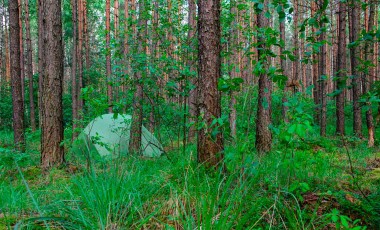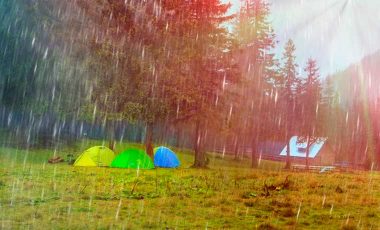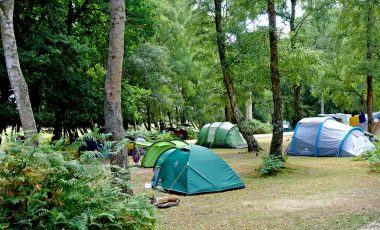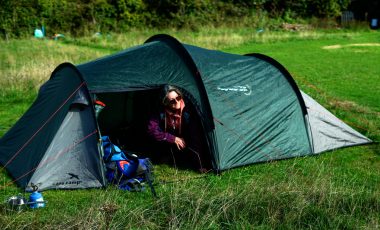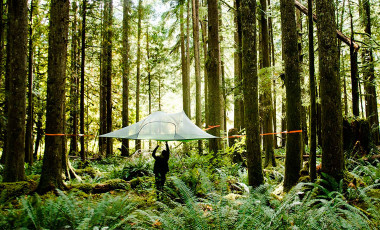Camping in the forest can be a real adventure and there are loads of woodland campgrounds that tick the boxes of most campers’ forest camping requirements. But for the more intrepid adventurers, camping wild in the woods can be the best way to truly experience the mystery and enchantment of the deep dark forest. Also known as ‘stealth’ camping, wild camping is what our ancestors did when the lands still belonged to everyone and there were no fences limiting their nomadic wanderings.
Today however, things aren’t quite so simple and there is lots to consider before heading out into the night with a backpack full of camping gear. As with wild camping anywhere outside of a campground, there are access laws that will limit the exploration of certain areas, so for more information on where you should or shouldn’t set up a stealth camp, take a read of our beach camping article. But to learn a few thing about how to stealth camp in the forest, read on.
Choosing a camping spot for stealth camping
Stealth camping is all about being as invisible as possible. Many of the do’s and don’ts for discreet beach camping also apply to stealth camping in the forest. But before you spend the whole day setting up the perfect Bear Grylls approved woodland campsite, there are a few additional things to consider:
- Find an area a good way off the trail that has little ground vegetation.
- Check the area for dead or rotting wood – you don’t want any dead branches falling from the trees above you.
- Make sure the ground is nice and flat and free from animal holes or rocks.
- Check the area for signs of frequent animal use, looking for footprints, feathers, trails and poop. Move on if there are signs that it is a nighttime hotspot for the forest natives.
- The spot should be on higher ground than any water sources in the area, so as to avoid any soggy nighttime interruptions from flood water.
- Being close (but not too close) to water is a bonus. Running water is best so that you can collect it easily for cooking and drinking. Make sure you have a good method to purify the water – boiling it is not always enough.
Setting up your stealth camping shelter
Once you’re happy with your spot, claim your woodland territory by getting your stealth camping shelter set up. It’s good to do this straight away incase there is bad weather looming. Doing it before dark is also key to avoid any unnecessary use of your flashlight that might draw unwanted attention.
The obvious abundance of trees makes for a perfect chance to have a non-tented shelter with a hammock and tarp set up. The extra distance between you and the cold, damp, bug ridden forest floor, holds instant appeal for suspended sleeping. You’ll remain unnoticed by any passing ground rodents sneaking around, and you are not as restricted by having to find good ground to sleep on. For a beginners guide on how to set up your hammock-tarp combo, take a look at this quick video:
Assuming you’ve set up a small tent or tarp that will blend with the woodland hues, then your camo set up might be too stealth for even you to find! If this is the case, then it’s a good idea to put some markers on the nearby trails to help you navigate your way back if you do wander away from it.
Monsters in the night
Now there’s definitely something about stealth camping in the forest that immediately creates a creepy atmosphere. Perhaps it’s the fear of the unknown of what might be lurking in the shadows, but at every crackle of a leaf or snap of a twig, the hairs on the back of your neck never fail to stand on end. How does that axe murderer always manage to find his way to your camping spot? Uncanny! Whatever is making the noises: raindrop, mouse or axe murderer, there are a few precautions you can take to put your mind at rest somewhat:
- Store your food in a solid and sealed container a good distance away from where your are sleeping. Suspend it off the ground so that any critters who are interested in a free midnight snack will have to work hard to get at it.
- If you are camping in bear territory, have a can of bear spray next to you at night and make sure you are fully clear of how to camp safely in bear country. Read and follow the advice that Grizzly and Wolf Discovery Centre have to offer.
- Wear ear plugs! If you know you’ve got nothing to worry about and it’s just your imagination playing tricks on you, then drown out the creepy noises completely.
- Keep a flashlight next to you so that if things do get more spooky than an innocent rodent scavenging for scraps, you won’t be left in the dark.
- If you’re really struggling to get the shadow monsters out of your head, then set up a trip wire around the perimeter of your camp with bells on to create an alert. Just don’t forget about it when you get up to pee in the night!
- If the monsters at your camp take on the form of mosquitos, then try burning some coils to fend them off.
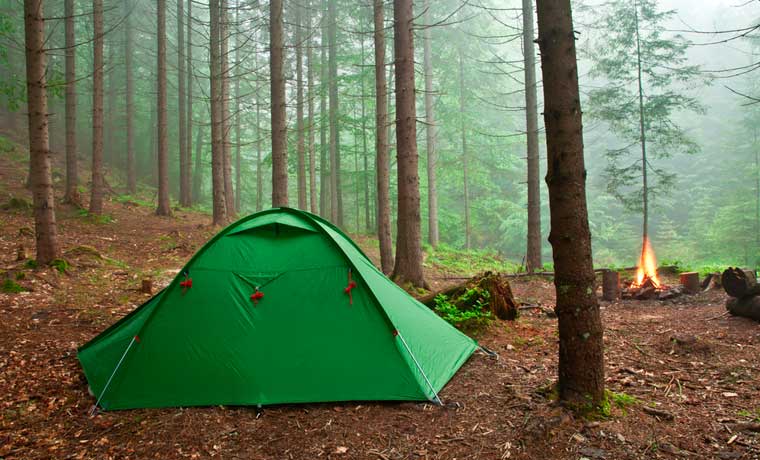
Forest fire
Having a campfire when stealth camping negates all that hard work that goes into disappearing into the woods, and kind of goes against the whole point of going unnoticed. But if you’ve been super smart about choosing your stealth camping spot then there are times when you can be pretty sure that a small fire won’t be seen by anyone. And if anyone does happen to saunter through the same part of the forest that you have claimed, a campfire is sure to put them right off coming anywhere near you. To them, you are the axe murderer just waiting for their next victim to stumble into your path! So if you are planning on having a fire, here are a few things to help you light up your camp safely and discreetly:
- Collect wood from the ground that is dry and dead. Avoid pulling branches off trees.
- Clear any dry leaves from the area surrounding your fire in anticipation for any flying sparks.
- Set the fire a good distance away from your camping spot. If anyone does approach you, they won’t know that you intend on sleeping the night there.
- Choose a spot for your fire that is in a dip or hollow to confine it’s glow to a smaller area.
- Have a good pile of dirt or soil on hand to smother the fire with if it gets out of hand.
- Keep the fire small and consider using a wood burning stove which will contain the fire and you can also cook on more easily.
- Make sure you fully put out the fire using water from the nearby stream, then cover up the ashes with dirt and replace the cleared leaves.
- Never light a fire during a fire ban, so check the fire risk status before you head out.

Tips to get the most out of stealth camping in the forest
Forest camping isn’t just about setting up stealthily, eating, sleeping and leaving. There are loads of ways to get the most out of the magic of the woods. Here are some of our ideas for forest fun:
Scavenger hunt – If you are with kids then a woodland scavenger hunt will keep them occupied for ages.
Stargazing – find a clearing in the woods during the daylight. Somewhere where the trees open up to reveal a good chunk of sky. Take a rug there after dark, lay back and enjoy the spectacle.
Animal watching – if you find any holes or burrows during the day, then mark where they are and revisit them at dusk. Sit down-wind of the burrows to lessen the chances of their inhabitants sniffing you out, and then wait quietly for them to creep out into the night.
Whittling – the perfect camping pastime, grab some wood, open your pocket knife and kick back in front of the fire to whittle away the evening.
Foraging – there is a whole host of woodland plants that can be enjoyed on your dinner plate, and if you know what you are looking for then you can create some delicious dishes with foraged goodies. Check out some of these recipes.
However you choose to enjoy your time camping in the forest, the most important thing is to be safe and leave no trace.



